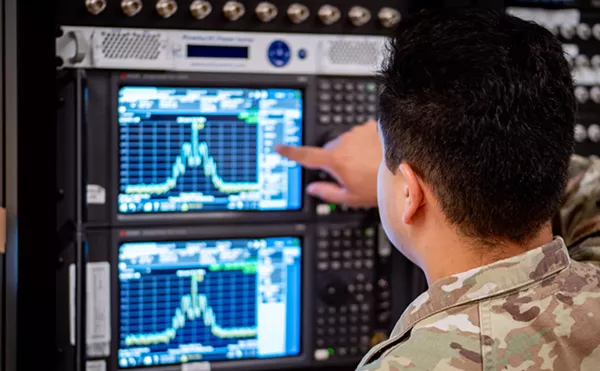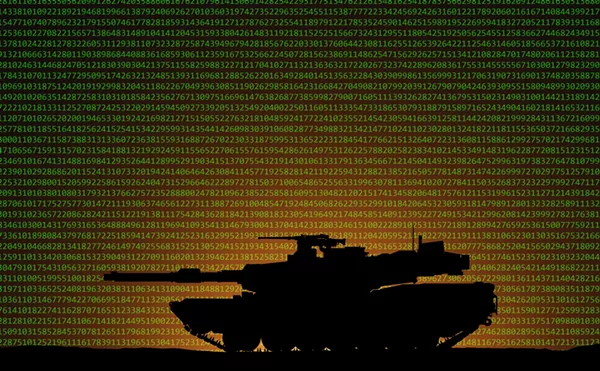No more. Today's pre-show advertising is exemplified by "FirstLook," produced by National CineMedia, a fast-rising firm affiliated with billionaire Phil Anschutz. These elaborate infotainment packages are larded with promos and mini-documentaries about forthcoming movies, TV series, video games and so forth, along with a liberal sprinkling of commercials. The material is bounced off a satellite from National CineMedia's massive headquarters in Centennial to more than 12,000 of the approximately 38,000 screens in the United States — and that number will go up in late 2008, when another 1,200-plus screens from the Loews Cineplex Entertainment group come online.
Plenty of ticket-buyers despise such advertising assaults. After all, they'd skip them using their TiVo or simply surf to another channel if they were at home. But at the theater, where the chairs are bolted to the floor facing the screen and remote controls don't work, these folks constitute a truly captive audience. "People don't have to see it if they arrive late," acknowledges Kurt Hall, National CineMedia's chairman and CEO, "but they may not get a seat — and if they do, it might not be a good one, especially with all the summer blockbusters out there now. Otherwise, the only way they can shut it off is to stop going to the movies."
Some viewers appear to be choosing this option. Movie attendance is down this summer in comparison with 2005 and 2006, probably because a much-hyped trio of threequels — Spiderman 3, Pirates of the Caribbean: At World's End and Shrek the Third — was too mediocre to inspire the return visits that send box-office receipts into orbit, and not enough smaller flicks, like writer/director Judd Apatow's popular Knocked Up, have over-performed. The movie-theater industry is limping along, too. In April, the Cinemark Holdings chain went public only to see its stock consistently trade below expectations — an unanticipated turn that likely helped convince execs at another major exhibitor, AMC Entertainment, to postpone a planned initial public offering last month.
In contrast, National CineMedia, which is jointly owned by Cinemark, AMC and Anschutz's Regal Entertainment Group (the largest theater chain in the U.S.), thrilled Wall Street in February with its own IPO, generating a windfall initially estimated at $798 million. Thanks to its share of the booty, as well as its acquisition of Loews, AMC posted its first annual profit in a decade.
But these short-term gains may only be the beginning. The theater biz will almost certainly transition from old-fashioned celluloid to newfangled digital files during the next few years, and the distribution method that National CineMedia uses for "FirstLook" serves as the blueprint for this switch. "From a design and architecture standpoint, what we do for our pre-show programming is very parallel to what would be done in full digital cinema," notes Earl Weihe, National CineMedia's senior vice president of operations.
National CineMedia's infrastructure would have to be amped up in a huge way to send actual movies to theaters via satellite. Weihe says the typical "FirstLook" contains about 7 gigabytes of data, as opposed to perhaps 200 gigabytes for encrypted features. Still, the company is presently testing satellite delivery of digitized films, and if the approach proves workable, the Centennial facility would be a logical place to base the operation. It's not beyond the realm of possibility that, a few years hence, more than a third of the movies seen by American movie-goers on any given day would originate from the Denver suburbs.
The concept behind National CineMedia can be traced to Regal CineMedia, which debuted in 2002. Over the next year, Regal outfitted theaters with digital projectors and other accoutrements needed to receive satellite transmissions; Hall says the cost-per-screen to do this now is around $10,000. Finally, in early 2003, the curtain opened on "The 2wenty," the awkwardly named precursor to "FirstLook." The response among movie lovers and media types was often ugly: When Hall appeared on Fox News with Neil Cavuto, the host declared, "I hate those ads," and predicted "a customer revolt." Even so, Regal stuck with "The 2wenty" as part of what Hall describes as "an educational process — educating people that this is part of the movie-going experience," and in 2005, the company formed National CineMedia as a joint venture with AMC; Cinemark jumped aboard a few months later. The next January, "FirstLook" launched with what Hall sees as better quality promotional segments and commercials, owing to an increased willingness on the part of advertisers to make material with theater screenings in mind and a strong emphasis on timeliness. He points out that "FirstLook" ends when a movie is slated to start, so customers won't feel they've been tricked into sitting through extra commercials.
Meanwhile, National CineMedia continued a Regal initiative to facilitate meetings and teleconferences, as well as to create special theater events — often concerts or one-off screenings. Predicting the success of the latter can be difficult. In May, a pre-recorded concert featuring Linkin Park was a relative disappointment even though the act's new CD, Minutes to Midnight, was a sales smash. In contrast, a screening of Dirty Dancing, an '80s staple that's aired frequently on TV, attracted a jaw-dropping 80,000 attendees, and Naruto The Movie: Ninja Clash in the Land of Snow, an anime movie not slated for American release at the time, brought in 39,000 fans at just 166 locations. According to Weihe, Naruto was so in-demand at one theater that a hundred people were lined up when it sold out — so the Centennial crew sent the file to an adjacent screen and let them watch it there.
The staffers who made the anime-niacs' dreams come true work at National CineMedia's network operations center, known colloquially as "the NOC," and a visit alongside Weihe and network services director Mike Ovecka provides a glimpse into the brave new digital world. A team of engineers mans rows of computer workstations in this figurative war room on a 24/7/365 basis, monitoring enormous streams of data typically dominated by the four versions of "First Look" — one for each of the standard movie ratings. The files are appended with local ads, most produced under the auspices of National CineMedia. Every commercial goes to every screen — a process that seems counterintuitive, since spots only meant for Iowa zip to New York, Oregon and everywhere else. Nevertheless, Ovecka insists that it's more efficient than if the separating were done in Centennial.
Content is also sent for monitors in lobbies, which, like everything else, are carefully tracked by folks such as John Guise, the NOC's daytime shift supervisor. To demonstrate the system's capabilities, Guise displays icons representing each state on a giant screen in front of him. All are green except Texas, and by clicking a series of buttons marked "Make It So!" in tribute to Jean-Luc Picard, he finds the problem: The equipment for one screen at one theater near Dallas isn't operating at its peak. About 70 percent of the time, such a fix can be accomplished remotely. Those that can't include swapping out lightbulbs in projectors — but Guise can look up the number of hours each has been used and alert workers at the theater when it's changing time.
The technology to expand digital satellite distribution to movies clearly works. Now, says Hall, "the next goal is to create a funding structure with a virtual print fee so that studios can fund the transition." He puts the equipment cost of going digital at $60,000 to $70,000 per screen, not to mention all that extra bandwidth expense — but with movie companies spending "hundreds of millions of dollars every year" to strike prints and transport bulky reels of easily broken or burned film to theaters, Hall believes digital is "a much better business model."
Until then, National CineMedia will keep pushing "FirstLook," and Hall argues that movie-goers' objections to it are waning. In a survey conducted for the company, he says, "We asked, 'Would you rather have what we're doing or a black screen?' And 90 percent picked what we're doing."
There's no telling how Muzak and trivia questions might have fared.












